Features -- Guangzhou -- 21 August 2019, updated 12 October 2019 with additional intersection proposals

The Guangzhou BRT opened in February 2010 and was hailed as a breakthrough innovation in BRT planning and design, influencing BRT planning worldwide with its high capacity 'direct service' operational mode in which BRT buses enter and leave the BRT infrastructure enabling passengers to complete more trips without transferring. The BRT system won major awards and hosted dozens of visiting delegations every year. The Guangzhou BRT inspired other BRT systems in China including in Chengdu, Lanzhou, Nanning and Yichang, as well as around the world. Regulators in the Communications Commission and related agencies set up an institutional and contracting scheme including multiple BRT operators which is an excellent model for other cities and an alternative to the monopoly operator approach used in other cities. The system has had a range of extremely impressive impacts which have somewhat surprisingly persisted over time.
By August 2019 peak hour operational speeds in the inner half of the corridor average only 13.8km/hr.
Yet since the opening of the system key problems have emerged and not yet been addressed. The result is that by August 2019 BRT operational speeds in the inner half of the corridor during peak hour trips surveyed by Far East Mobility averaged only 13.8km/hr, which is very low in comparison to BRT speeds worldwide. AM peak bus speeds in the central portion of the corridor are as slow as they were before the BRT was implemented. These low operational speeds are a consequence of the factors presented in this article.
Speed samples are taken from the following BRT routes:
In this article we present the eight steps needed to drastically improve the Guangzhou BRT and improve peak hour speeds to at least 23km/hr. Most of the data is based on earlier surveys, but these earlier surveys are still valid because all of the key issues remain unchanged. Even the BRT routes have undergone only very minor changes over the first decade of operation. The steps needed are:
- Introduce 300 18m BRT buses in routes operating outside the BRT corridor.
- Adjust the BRT routes. Extend BRT route B1 to Huochezhan. Take some BRT routes out of the BRT system (before the new 18m buses are operational). Cancel 4 BRT routes and adjust 6 routes to better meet demand.
- Improve intersections. Provide at least 40% green time for BRT movement at intersections. Reduce Tiyu Donglu and Tianhe Donglu intersections to 2-phase. Provide two BRT queue lanes at the intersection at Keyun Lu.
- Enforce bus-only lanes. Ban non-BRT vehicles from the BRT lanes and in peak hours enforce a single BRT lane at the two flyovers.
- Install physical BRT lane dividers.
- Monitor and ensure good off-peak service.
- Raise the speed limit for BRT bus drivers to at least 70km/hr from 40km/hr.
- Implement phase 2 BRT in Huanshi Dong Lu, Huangpu Avenue and Dongfeng Lu.
Each of these Eight Steps is discussed and explained in turn.
Step 1: Introduce 300 18m BRT Buses in Routes Operating Outside the Corridor
There have been no high capacity BRT buses added to the fleet since 2010, when 36 18m BRT buses were brought into operation. (The total BRT bus fleet is around 1,000 buses.) This contrasts with BRT systems in other Chinese cities such as Jinan, Hangzhou, Changzhou, Beijing, Xiamen and Chengdu which all have much lower bus and passenger throughput and smaller BRT system bus fleets, but well over 100 18m BRT buses. All BRT systems with a passenger throughput exceeding 9,000 passengers per hour per direction - Bogota, Guangzhou, Istanbul, Lima, Chengdu, Xiamen, Cali and Urumqi - have either fully or mostly 18m BRT bus fleets except for Guangzhou. Guangzhou, with more than 20,000 passengers per hour per direction, is second only to Bogota in passenger throughput and Bogota is now implementing a fleet of even larger, bi-articulated 25m BRT buses. Guangzhou, meanwhile, still has 97% 12m BRT buses.
 Bogota is currently procuring more than 1,000 new bi-articulated, 25m BRT buses.
Bogota is currently procuring more than 1,000 new bi-articulated, 25m BRT buses.
 18m BRT buses in Cali, which has only half the maximum passenger throughput of Guangzhou.
18m BRT buses in Cali, which has only half the maximum passenger throughput of Guangzhou.
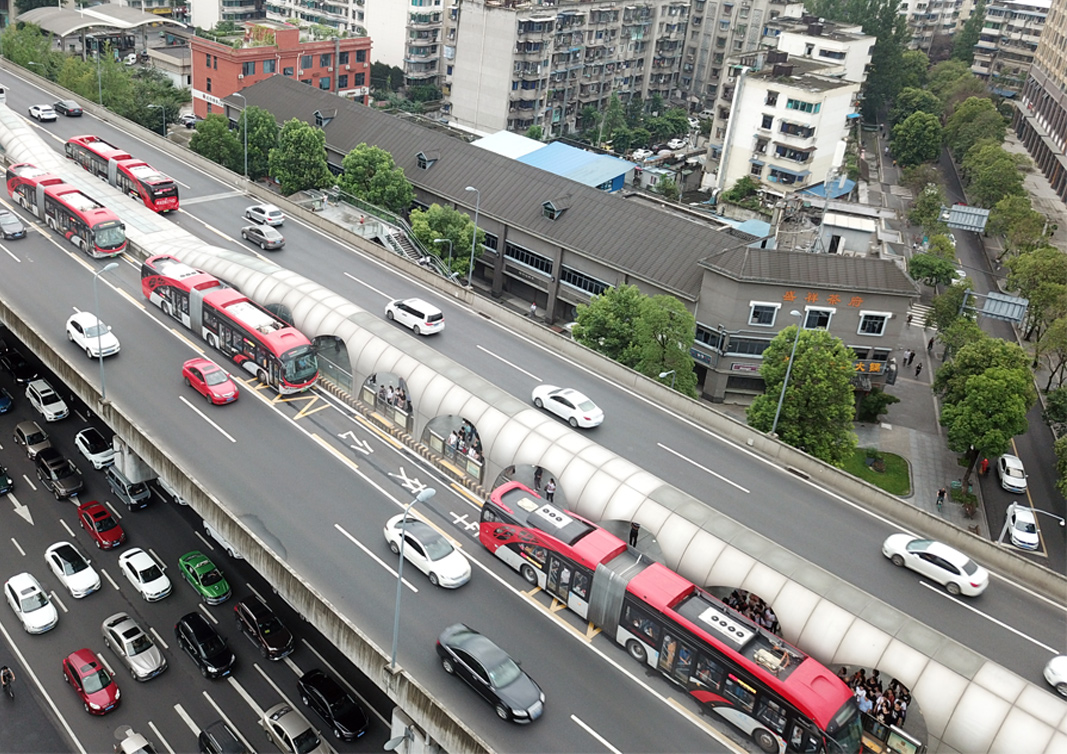 18m BRT buses in Chengdu.
18m BRT buses in Chengdu.
 18m BRT buses in Urumqi.
18m BRT buses in Urumqi.
The Guangzhou BRT stations were designed to accommodate 18m BRT buses and Guangzhou should have at least several hundred 18m BRT buses in operation. This would significantly reduce crowding and improve BRT speeds.
In China and worldwide, BRT systems with much lower passenger and bus throughput have high capacity BRT bus fleets, often accounting for more than 50% of all BRT vehicles. In Guangzhou, high capacity buses account for just 3.6% of the BRT fleet.
BRT station performance is heavily influenced by the number of buses stopping at the station, with stopping buses occupying the station for around 11 seconds even without any boarding passengers due to the time required to stop, open doors and depart. With a significant number of boarding and alighting passengers, buses will often occupy the station for 30 seconds or more. At the very high bus frequencies found in the Guangzhou BRT, this leads to queuing and delays at the stations.
One of the easiest ways to dramatically reduce station saturation and hence speed up boarding and alighting and bus speeds at stations is to use larger buses. Even without improvements to routes, dramatic reductions in saturation can be achieved by changing to larger buses, largely eliminating queuing problems at stations and improving operating speeds by more than 30%. Higher speeds in turn mean that BRT fleet requirements can be reduced, with the same number of buses serving more passengers, leading to higher system efficiencies and operating cost savings. The following graphic shows BRT station saturation in the 26 BRT stations and two directions in the AM peak hour, based on the current configuration and one in which buses are changed to 18m BRT buses. With 18m BRT buses, saturation falls within an acceptable range of less than 50% and is primarily less than 40%.
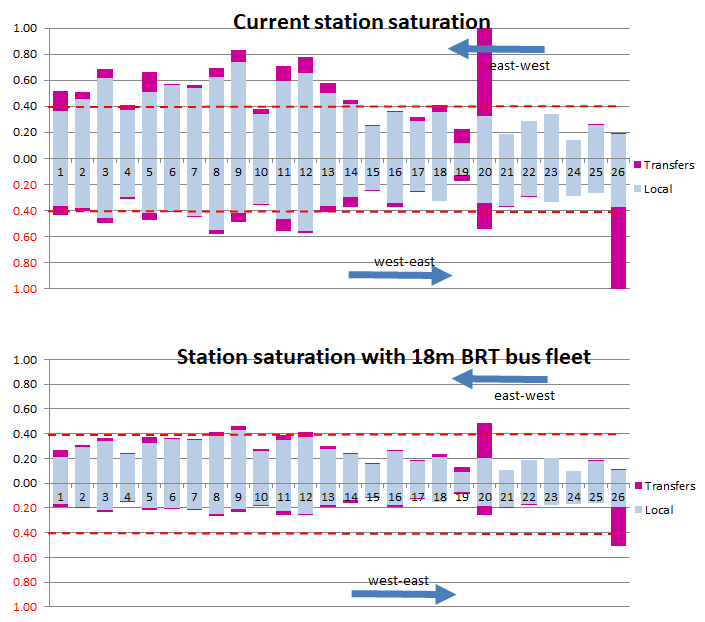 Morning peak station saturation along the BRT corridor with current configuration (nearly all 12m BRT buses; most stations oversaturated) and with 18m BRT buses (saturation issues disappear).
Morning peak station saturation along the BRT corridor with current configuration (nearly all 12m BRT buses; most stations oversaturated) and with 18m BRT buses (saturation issues disappear).
In April 2019 the Chinese People's Political Consultative Conference (CPPCC) proposed expanding the 18m BRT bus fleet in Proposal No. 20190464 for the Second Session of the 12th CPPCC in Guangdong Province. The Guangzhou City Government responded in July 2019 that more 18m BRT buses are not needed because they are only used on route B1, and route B1 already has sufficient 18m buses for the demand levels. And they stated that 18m BRT buses could not be used on routes other than B1 due to road conditions and turning requirements for the larger buses, especially outside the BRT corridor.
The argument that route B1 already has enough 18m BRT buses is valid. In fact, as shown below, the fleet allocated to route B1 should be decreased, not expanded. However, the argument that 18m BRT buses cannot or should not be used on BRT routes operating outside the corridor is clearly wrong. The larger 18m BRT buses actually require less turning space than 12m buses, as shown in the following graphic.
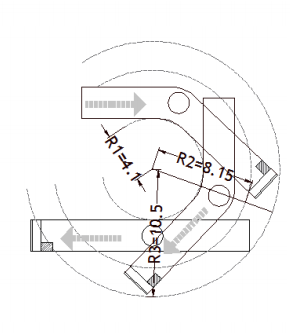 Turning radius of 18m long articulated buses: outer radius = 10.5m.
Turning radius of 18m long articulated buses: outer radius = 10.5m.
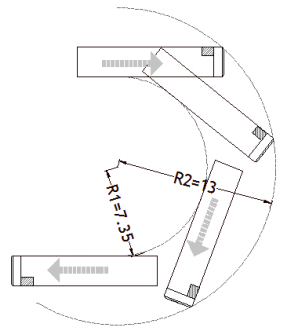 Turning radius of 12m long regular bus: outer radius = 13m.
Turning radius of 12m long regular bus: outer radius = 13m.
 18m bus operating in central Paris.
18m bus operating in central Paris.
 18m bus operating in the historic core of Nantes, France.
18m bus operating in the historic core of Nantes, France.
Despite the larger size, 18m buses can operate even in quite narrow roadways and can turn in tighter spaces than 12m buses. It is common for example in the narrow roadways in the historic core of European cities to see 18m buses operating, and 18m buses operate in many Chinese cities.
Step 2: Adjust the BRT Routes and Extend B1
i. Drastically reduce transfers
Many problems in BRT operations can be improved or solved through changes in BRT operation including route adjustments. One of the most severe problems is that passengers are forced to make too many transfers, to their detriment in terms of inconvenience and longer trip times, and also to the system's detriment in terms of greater BRT fleet requirements and slower operational speeds.
The Guangzhou BRT was planned and designed as a 'direct service' system in which BRT buses would enter and leave the BRT corridor without passengers needing to transfer. As part of the direct service operational design, there were no transfer terminals or interchanges in the corridor. Yet the initial BRT route planning tended to more closely match a traditional trunk and feeder configuration. Under this approach, many routes are terminated at the first BRT station, with passengers required to transfer to other routes to continue their trip.
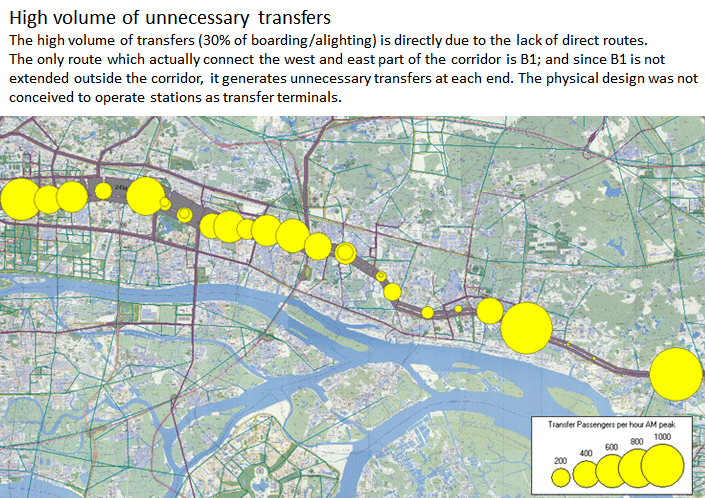
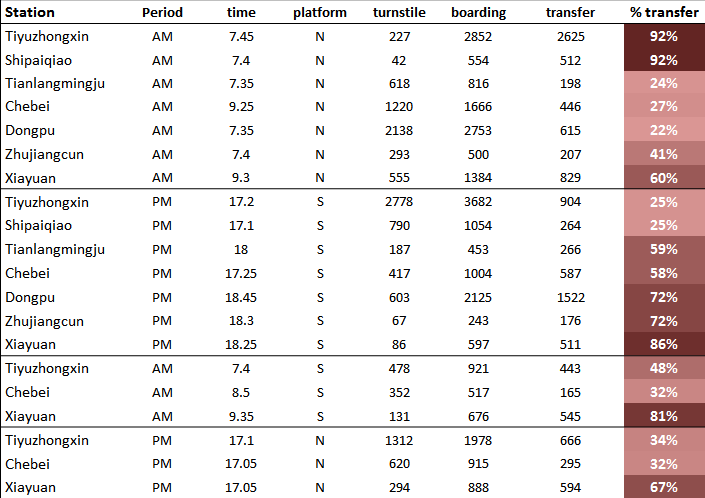 Transfer volumes and proportions in peak hours in BRT stations.
Transfer volumes and proportions in peak hours in BRT stations.
The result of this operational approach which is not well-matched to the BRT infrastructure is an extremely high level of transfers at some BRT stations, as shown in the table above. At Tiyu Zhongxin station during the morning peak, for example, on the main citybound platform in the morning peak more than 90% of passenger boardings are from passengers who are transferring from another BRT bus. System-wide, around 30% of the boarding and alighting events during the morning peak involves transferring passengers. Route adjustments are needed to reduce transfers, improve speeds and reduce fleet requirements and operational costs.
ii. Extend B1 to Xiaobei or the Guangzhou Railway Station
Route B1 is a root cause of many problems in the Guangzhou BRT. The B1 BRT route runs from the first to last BRT station and is particularly problematic because less than 10% of trips by BRT passengers are from one BRT station to another (which would be directly served by B1 without needing a transfer). More than 90% of BRT system trips either start at a station inside the BRT corridor and finish outside, or start outside the corridor and finish inside, or start and finish outside the BRT corridor. B1 does not match the corridor demand and forces many transfers. The situation is made worse by the fact that all 36 18m BRT buses are operated only in the B1 route. (Regulators unfortunately and inexplicably consider that the 18m buses can only be used in the B1 route.)
The solution is to extend B1 along Huanshi Lu to the Guangzhou Railway Station. B1 should also be extended at the eastern end of the corridor, where currently around 1,000 passengers per hour are forced to transfer.
Extending route B1 to the Guangzhou Railway Station and extending either B1 or route B30 beyond the easternmost station (Xiayuan) would dramatically reduce transfer volumes, improve system speeds, and reduce BRT fleet requirements. The change should be made immediately, with tens of thousands of passengers benefiting each day.
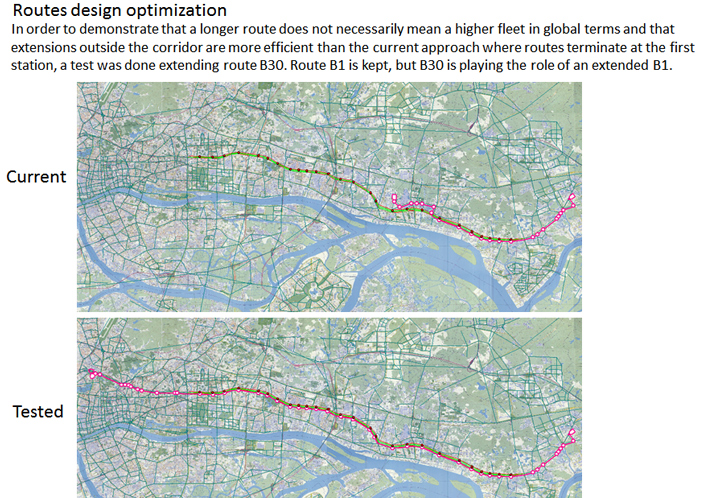
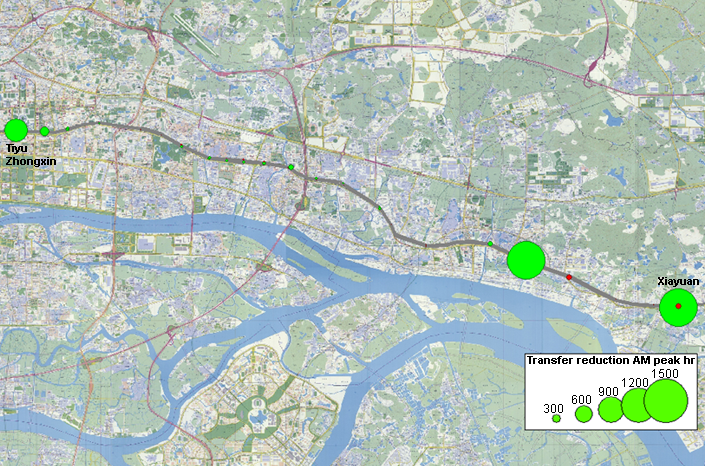 A single change to route B30 so that it extended beyond the current route B1 would have system-wide benefits by reducing transfers by more than 3,500 in the morning peak hour and at the same time reduce operating costs.
A single change to route B30 so that it extended beyond the current route B1 would have system-wide benefits by reducing transfers by more than 3,500 in the morning peak hour and at the same time reduce operating costs.
The test of this single route change results in a new equilibrium of frequency for each route according to its demand. Route B1 is now only used for direct trips without transfers, and its demand drastically drops from 8,000 boardings/hr to 2,500 boardings/hr. There is a global BRT fleet reduction of 24 buses, reducing BRT operating costs. There is a reduction of 3,500 transfers/hour ~= 7,000 seconds in station saturation or more than 2% improvement to overall BRT operation. Extending route B1 to reduce transfers in this way only generates benefits. There are no disadvantages.
- Passengers enjoy faster travel time, less transfers, and more comfort and convenience.
- Operators have reduced costs.
Of course this is just one single route modification. Many more adjustments should be made, on a regular basis. A detailed analysis of transfers needs to be carried out to develop proposals for similar adjustments, reducing transfers to the minimum.
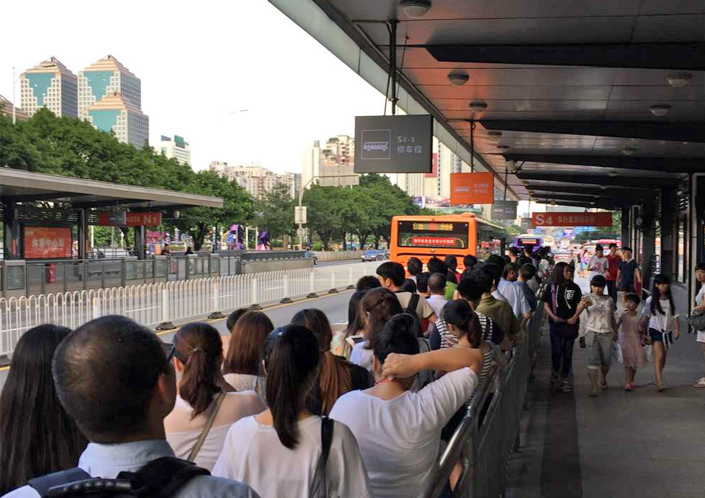 Passengers queue to board route B1 during the evening peak on 26 July 2016 at the first BRT station at Tiyu Zhongxin. More than 90% of the outbound passengers boarding at Tiyu Zhongxin station in the evening peak are transferring, and many of these must transfer again after alighting from B1.
Passengers queue to board route B1 during the evening peak on 26 July 2016 at the first BRT station at Tiyu Zhongxin. More than 90% of the outbound passengers boarding at Tiyu Zhongxin station in the evening peak are transferring, and many of these must transfer again after alighting from B1.
iii. Move routes B8, B11, B15, B18, B18K and B19 out of the BRT until the new 18m buses are operating
When the new 18m BRT buses are in operation, the system will have capacity to accommodate more routes at a good level of performance. Until then, routes B8, B11, B15, B18, B18K and B19 should be moved out of the BRT system. The routes can still use Zhongshan Avenue, but will stop at kerbside bus stops instead of using the BRT stations.
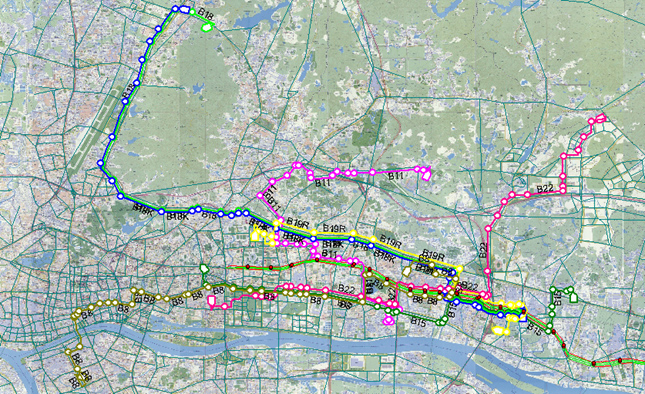 Routes B8, B11, B15, B18, B18K and B19 should be removed from the BRT until the new fleet of 18m BRT buses is in operation.
Routes B8, B11, B15, B18, B18K and B19 should be removed from the BRT until the new fleet of 18m BRT buses is in operation.
iv. Cancel routes B13, B14, B23 and B27
These routes overlap with existing route coverage and can be cancelled.
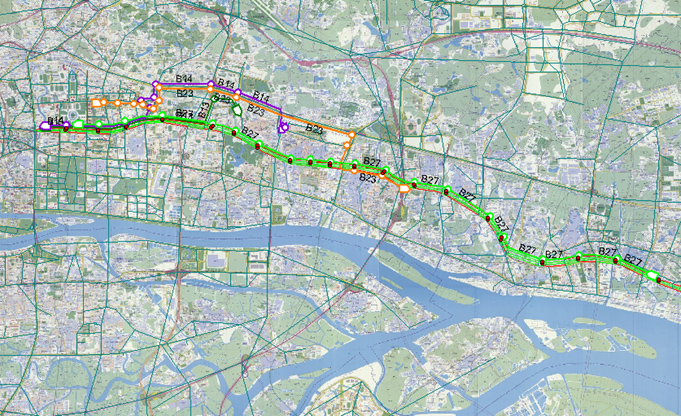 Routes B13, B14, B23 and B27 should be cancelled.
Routes B13, B14, B23 and B27 should be cancelled.
v. Adjust routes to better serve demand
Changes to BRT routes should be made more frequently as part of a regular process, with monitoring of impacts and changes in demand. In any BRT system it is necessary to monitor operations in order to identify and rectify problems. Regular adjustments should be made, but this has generally not been done in Guangzhou. The severe transfer problems have persisted through nearly a decade of BRT operation. Several route adjustments are needed, with impacts of changes monitored, and then further adjustments made.
An example of a route adjustment to better serve local demand is that B17 should operate along Dashadong (overlapping with the metro in this section) rather than Fengle Lu.
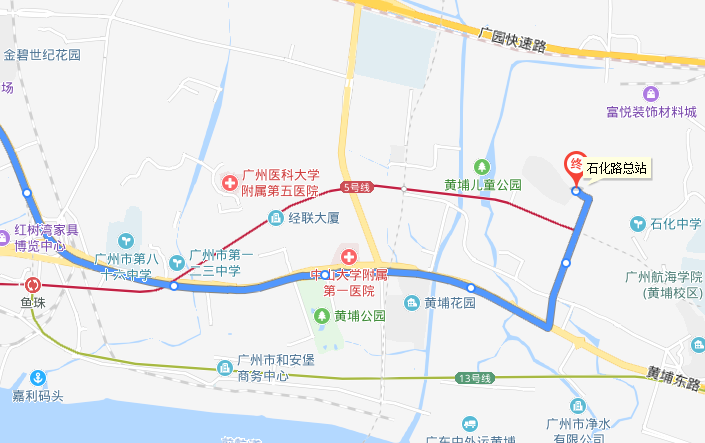 Route B17 (in blue) operating along Dashadong (in red, overlapping in this part with the line 5 metro) would better serve local demand.
Route B17 (in blue) operating along Dashadong (in red, overlapping in this part with the line 5 metro) would better serve local demand.
vi: Introduce express routes
The Guangzhou BRT was designed with overtaking lanes, enabling the implementation of express routes. Express services provide many advantages:
- Increased speed/reduced travel time for passengers
- Reduced BRT fleet requirements and hence operating costs
- Reduced BRT station saturation and crowding
- Equilibriating services to avoid overcrowded buses.
Following are two examples of express routes based on route B4 and B21. For route B4, the same four services are changed. A service currently running outside the BRT corridor along the Guangyuan Expressway is included in the BRT corridor, with just two stops at BRT stations. One service remains unchanged, stopping at each station. The two other services operate at specific stops according to the passengers' origin-destination profile of the line. For route B21, the route is split into two services with alternating stops.
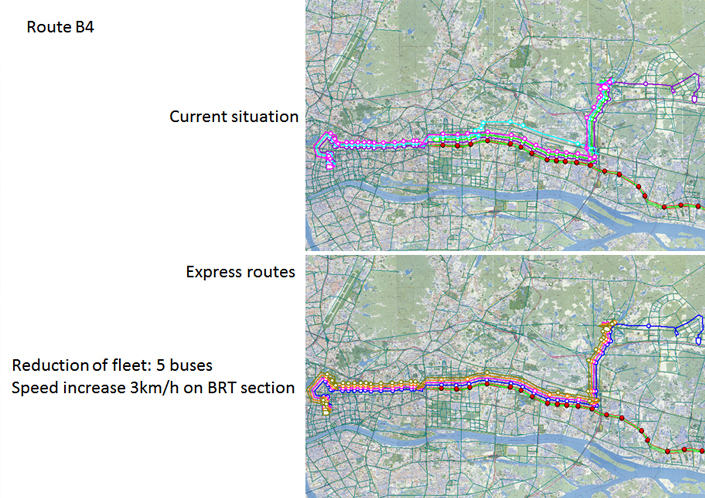

 Express routes have been only partially implemented, and often involving moving routes outside the BRT corridor, because the oversaturation of stations does not allow for significant speed advantages for express routes.
Express routes have been only partially implemented, and often involving moving routes outside the BRT corridor, because the oversaturation of stations does not allow for significant speed advantages for express routes.
Some express routes currently operate outside the BRT corridor along the Guangyuan Expressway, such as B18K. Ideally, this route should operate inside the BRT corridor, not outside. When the issues of oversaturation are addressed, especially when larger buses are added, express routes can use the BRT corridor rather than the expressway.
Step 3: Reduce Tianhe Dong Lu and Tiyu Dong Lu Intersections to 2 Phases
The Guangzhou BRT speed is effectively crippled by very long delays at three key intersections: Tianhe Donglu, Tiyu Donglu and Keyun Lu. Long queues from the four-phase intersections block the BRT stations, and it is not uncommon for BRT buses to need to wait for two or three separate signal cycles before being able to pass the intersections. Intersections are currently the main source of delays, though queuing exacerbated by mixed traffic at stations also causes significant delays. Improvements to these intersections and especially the allocation of a much higher proportion of green time for the BRT is essential to achieve signficant speed improvements.
As seen following, intersections account for most of the delays and slow speeds. BRT buses from Zhucun (roughly midway along the BRT corridor) in the inbound direction to Tiyu Zhongxin in the morning peak spend 17 minutes queuing at intersections; primarily at the four intersections at Keyun Lu, Tianfu Lu, Tiyu Donglu and Tianhe Donglu. A combination of measures including intersection phase reductions, a higher proportion of green time to the BRT, and larger buses can dramatically reduce this intersection delay to around 2 minutes on average, saving 15 minutes and increasing average speeds by around 6km/hr.
Sources of delay between Zhucun and Tiyuzhongxin in the AM peak in surveys in August 2019.
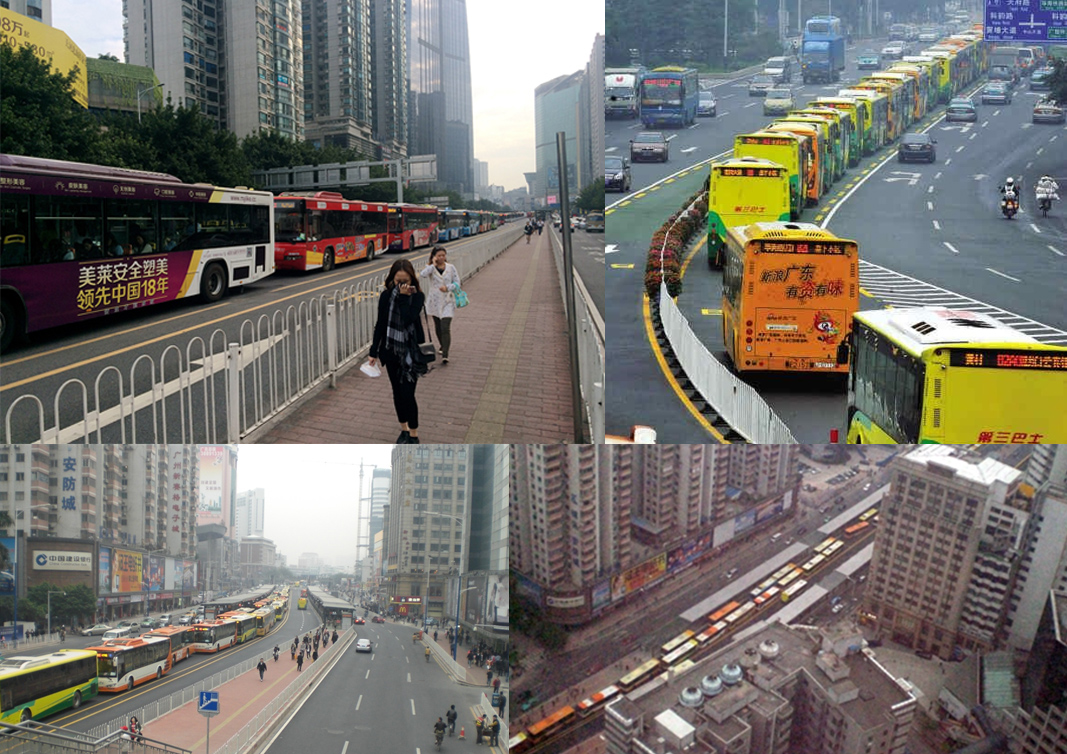
 Long queues of buses caused by intersection delays at Tianhe Dong Lu, Tiyu Dong Lu and Keyun Lu.
Long queues of buses caused by intersection delays at Tianhe Dong Lu, Tiyu Dong Lu and Keyun Lu.
Key changes needed are:
- Change Tiyu Dong Lu intersection from 4 phases to 2 phases (or possibly 3 with an all-pedestrian phase; more study is needed).
- Change Tianhe Dong Lu intersection from 4 phases to 2 phases.
- Enforce 7AM to 9PM BRT-only lanes on the flyovers at Wushan and Shidajida.
- Build a BRT-only flyover at Tianfu Lu, or alternatively provide and additional BRT queue lane.
- Add a BRT queuing lane at the intersection of Keyun Lu, with two BRT queuing lanes at each approach.
These proposed changes, along with the alternative left turn circulations related to Tiyu Dong Lu and Tianhe Dong Lu, are shown in the following graphics.
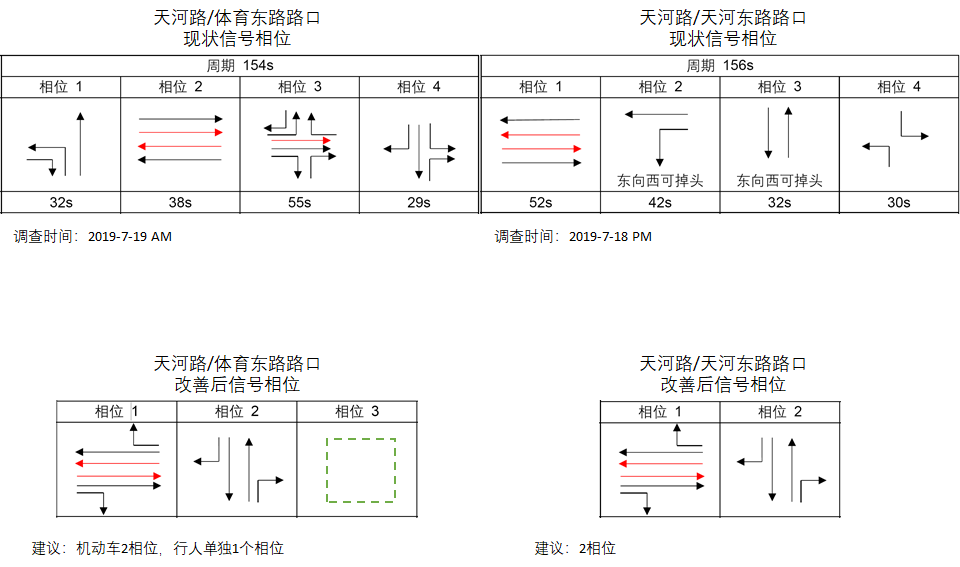 Current and proposed intersection phases at Tiyu Dong Lu and Tianhe Dong Lu.
Current and proposed intersection phases at Tiyu Dong Lu and Tianhe Dong Lu.
Tiyu Donglu and Tianhe Donglu should reduced to two phases to improve BRT operation. If 3 phases are used at Tiyu Dong Lu, a BRT green time of at least 40% should be ensured. There are multiple network turning options for mixed traffic.
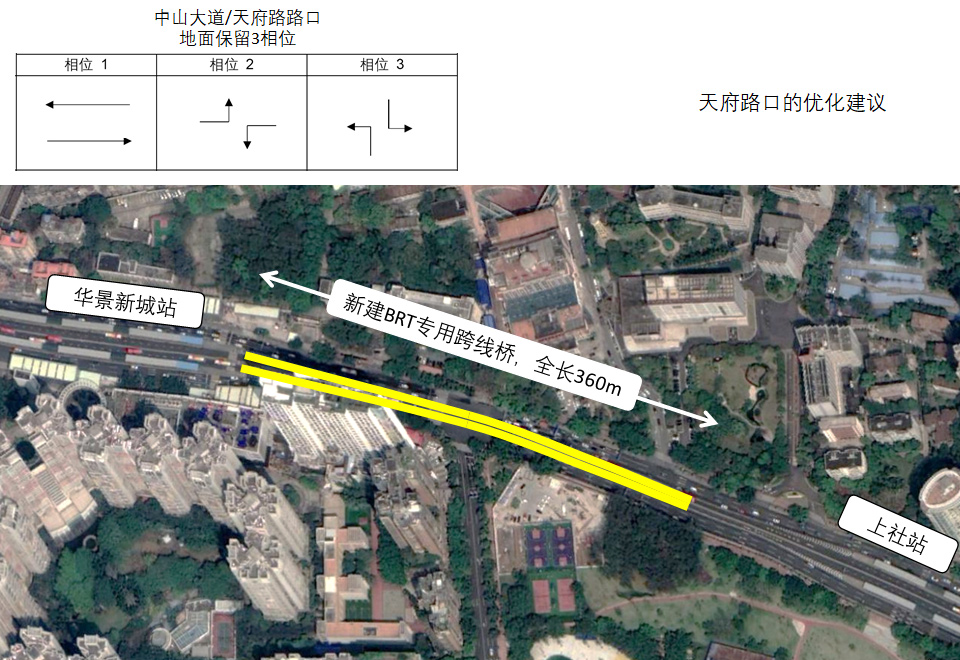 A BRT-only flyover should be implemented at the intersection with Tianfu Lu or alternatively an additional queue lane added for the BRT.
A BRT-only flyover should be implemented at the intersection with Tianfu Lu or alternatively an additional queue lane added for the BRT.
 An additional BRT queue lane is needed at the approaches to the Keyun Lu intersection, where long queues of BRT buses are common.
An additional BRT queue lane is needed at the approaches to the Keyun Lu intersection, where long queues of BRT buses are common.
Step 4: Enforce Bus-Only Lanes
The Guangzhou Communications Commission in May 2016 issued the Zhongshan Avenue BRT Management Regulation 《中山大道快速公交系统管理办法》 stipulating that in peak hours cars can enter the BRT lanes under the guidance of traffic police. See this article for a brief overview of this issue.
Noting the high bus frequency and demand, it is impossible to achieve good operating speeds if mixed traffic is allowed into the BRT lanes. This policy will need to change if the BRT is to provide any meaningful bus priority.
A recently issued directive from the Ministry of Transport says:
(6) Improve the speed of bus operation. Increase the construction of bus lanes, and prioritize the formation of continuous and networked bus lanes in urban centers and traffic-intensive areas. Strengthen the supervision and control of the use of bus lanes, and increase the enforcement of illegal traffic occupation of bus lanes.
Twelve departments and units such as the Ministry of Transport on the issuance of Green Travel Plan of Action (2019-2022) regulation [2019] 70
http://www.gov.cn/xinwen/2019-06/03/content_5397034.htm
Wushan Lu flyover in November 2015. Now, as well as occupying the BRT lanes, cars often enter the BRT stations too. BRT-only lanes on the flyover are needed in the peak hour, with mixed traffic on the flyover during off-peak hours.
Mixed traffic allowed to enter BRT lanes and stations.
Step 5: Install Physical BRT Lane Dividers
The Guangzhou BRT does not have physical BRT lane dividers, relying on camera and traffic police enforcement to keep non-BRT vehicles out of the BRT lanes. These measures, as is common internationally, are ineffective. Physical lane dividers and barriers are needed to keep non-BRT vehicles out of BRT lanes, even when the non-BRT lanes are heavily congested. The physical lane dividers can be relatively easily and quickly implemented in Guangzhou.
Segregated bus lanes are a basic requirement of any meaningful bus priority or BRT system. Physical lane dividers should be installed to prevent non-BRT vehicles from entering BRT lanes.
 Segregated BRT lanes in Bogota, Colombia.
Segregated BRT lanes in Bogota, Colombia.
 Segregated BRT lanes in Cali, Colombia.
Segregated BRT lanes in Cali, Colombia.
 Segregated BRT lanes in Mexico City.
Segregated BRT lanes in Mexico City.
 Segregated BRT lanes in Jakarta, Indonesia.
Segregated BRT lanes in Jakarta, Indonesia.
 Segregated BRT lanes in Yichang.
Segregated BRT lanes in Yichang.
 Segregated BRT lanes in Urumqi.
Segregated BRT lanes in Urumqi.
Step 6: Monitor Bus Occupancy and Off-Peak Service
One of the basic tasks of any BRT or public transport regulatory agency is to monitor the service quality provided by the system's operators and to take remedial and policy action accordingly. Crowded buses and station are understandable during peak hours, but should not be seen during off-peak periods.
During the morning peak hour in late July 2016 the average citybound BRT bus occupancy was 87 passengers. This is a severe level of overcrowding considering nearly all of the buses used in the BRT are 12m buses, and compares to an average occupancy of 78 passengers per bus in surveys in 2014. On average there are now more than 50 standing passengers per bus at the highest demand locations.
The overcrowding has negative implications for passenger comfort but also for system performance. It can take up to 10 seconds or more for a single passenger to exit a BRT bus, and waiting passengers cannot squeeze into the BRT buses at many stations. This greatly increases delays at stations and degrades the operational speed of BRT buses. Slow boarding and alighting at stations also often leads to severe peak hour bus queuing delays.
Regulators should monitor bus occupancy and set a policy limit on acceptable levels of crowding, taking action to improve the situation when the policy limits are exceeded. The BRT system is still far below the capacity limits imposed by the design. A policy limit on permissible crowding at different times of the day can guard against the tendency of reducing off-peak operational bus-kilometers (which is the basis of operator payment), leading to overcrowding even during off-peak hours.
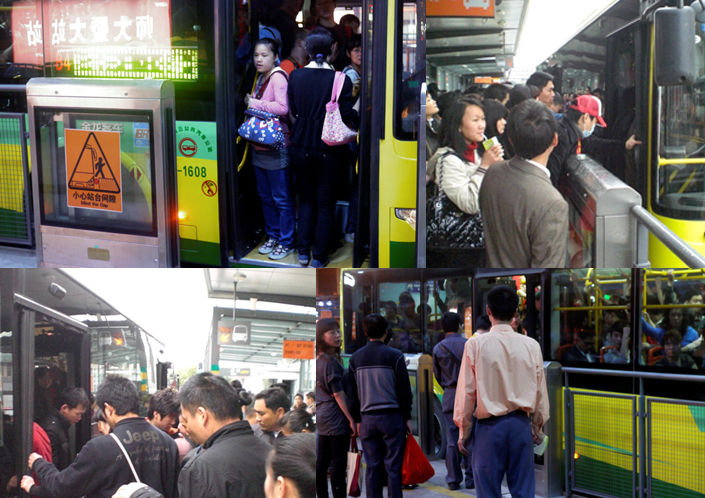 Severe overcrowding is commonplace in the Guangzhou BRT during peak hours, and even during off-peak hours the bus occupancy levels are often too high. The overcrowding slows boarding and alighting, reducing system speed and performance.
Overcrowding of stations and buses during peak hour leads to slow boarding and alighting, causing delays and slow average operational speeds.
Severe overcrowding is commonplace in the Guangzhou BRT during peak hours, and even during off-peak hours the bus occupancy levels are often too high. The overcrowding slows boarding and alighting, reducing system speed and performance.
Overcrowding of stations and buses during peak hour leads to slow boarding and alighting, causing delays and slow average operational speeds.
Step 7: Raise the BRT Bus Speed Limit to 70km/hr
BRT drivers are instructed to drive at a maximum of 40km/hr along the BRT corridor. This speed is too low and should be increased to 70km/hr.
Step 8: Implement Phase 2 BRT in Huanshi Lu, Huangpu Ave and Dongfeng Lu
More than 90% of the trips of BRT passengers include sections outside the BRT corridor, with a large portion using Huanshi Road, Dongfeng Road and Huangpu Avenue. Providing faster and improved access to these areas requires the extension of the BRT corridor.
Additional BRT corridors should be planned, designed and implemented. The initial focus should be on extension along Huanshi Lu to the Guangzhou Railway Station, because this is highly complementary to the current passenger demand using the BRT system, and implementation along Dongfeng Lu and Huangpu Avenue because this can reduce the demand pressure on the parallel phase 1 BRT corridor.
Other high priority corridors which should be considered for BRT implementation include:
- Sanyuanli Avenue, Jichang Avenue and Jiefang Avenue
- Guangzhou Avenue
- Xingang Road and Changgang Road
- Gongye Avenue
- Zhongshan Road.
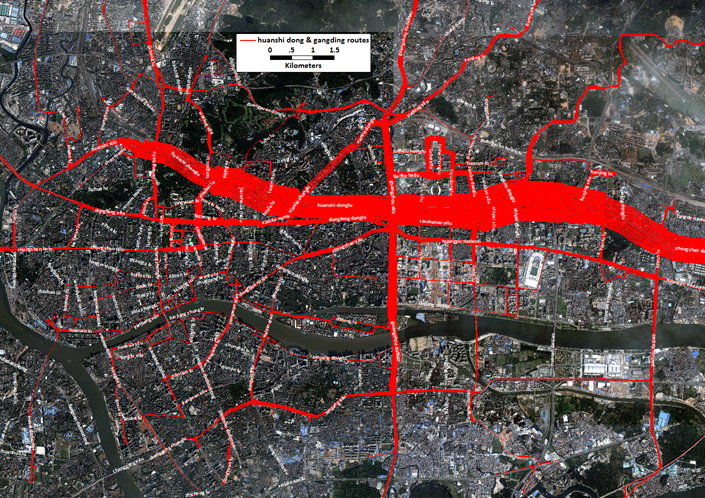 Bus routes operating in both Gangding (in the BRT corridor) and Huanshi Dong Lu, showing a strong concentration of routes.
Bus routes operating in both Gangding (in the BRT corridor) and Huanshi Dong Lu, showing a strong concentration of routes.
 BRT demand from the current BRT route configuration, showing the high BRT passenger flow along Huanshi Lu past the western end of the corridor.
BRT demand from the current BRT route configuration, showing the high BRT passenger flow along Huanshi Lu past the western end of the corridor.
Rendering of a proposed high capacity BRT station at the Garden Hotel (1)
Rendering of a proposed high capacity BRT station at the Garden Hotel (2)
Rendering of a proposed high capacity BRT station at Xiaobei
Suggested Step 9: Improve Station Access
At Gangding BRT station a pedestrian bridge designed as a temporary structure with a one year lifespan is still operating nearly a decade later. The bridge is permanently crowded, unprotected from the weather, and generally unpleasant and inconvenient to its tens of thousands of daily users. At the other end of Gangding station, which is possibly the largest non-terminal BRT station in the world in terms of daily passenger boardings, tens of thousands of passengers each day are forced to walk 100m from the BRT bridge to the station platform without any shade or weather protection.
Meanwhile at Shipaqiao BRT station, passengers are forced to walk 200m from the Tiyu Donglu intersection in order to access the station, also with no shade or weather protection.
 A narrow, steep, temporary bridged initially designed for one-year operation is still being used for BRT station access nearly a decade later. A new bridge or tunnel should be provided.
A narrow, steep, temporary bridged initially designed for one-year operation is still being used for BRT station access nearly a decade later. A new bridge or tunnel should be provided.
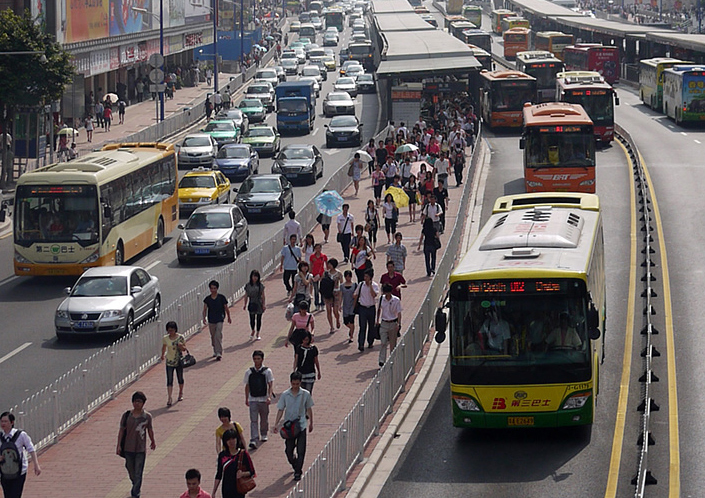 Thousands of people each day need to walk across this exposed area to access the Gangding BRT station. Shade from trees or structures would be relatively easy to implement.
Thousands of people each day need to walk across this exposed area to access the Gangding BRT station. Shade from trees or structures would be relatively easy to implement.
Station access improvements can also be made at other stations. A station area improvement plan should be developed and implemented along the BRT corridor, taking into account not only the corridor but also perpendicular access roads to the corridor.
Article by Karl Fjellstrom, Far East Mobility. Karl was the lead international expert during the planning and design of the Guangzhou BRT system and in 2011 received the Guangzhou Friendship Award, which is the highest honour granted by the Guangzhou City Government to foreign experts, in recognition of his role in the Guangzhou BRT planning and design.